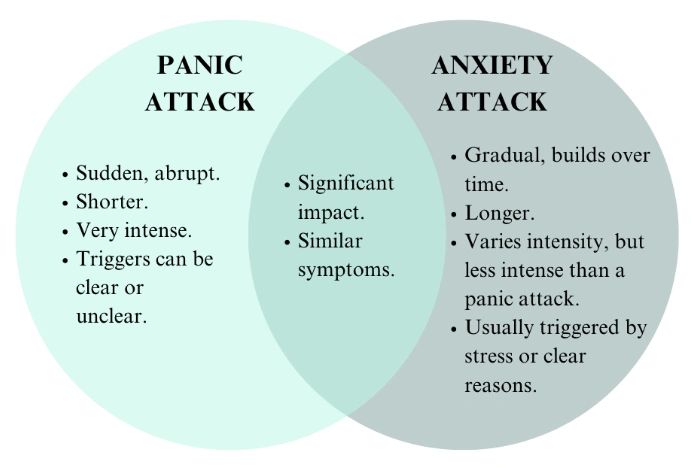Panic Attacks: How Can I Recognize One?
.webp)
By: Kaitlyn DeStefano, B.A., Sophy Kaplan, B.A., Fugen Neziroglu, PhD.
What is a Panic Attack?
Panic attacks are sudden, intense episodes of anxiety, where an individual experiences both physical and psychological symptoms of panic. They can be expected, as in a response to a feared stimulus, or unexpected, as if occurring for no apparent reason. Panic attacks can reach their peak within just a few minutes, making their effect on an individual abrupt and terrifying for the individual having one.
Panic attacks can serve as diagnostic or severity indicators, with different conditions varying in the prevalence or after-effect of panic attack occurrence. They are transdiagnostic – meaning that they can be found within multiple disorders, including, but not limited to: panic disorder, generalized anxiety disorder, post-traumatic stress disorder, and specific phobias.
However, panic attacks are common, with many individuals (even those without psychological disorders) experiencing at least one in their lives. If panic attacks are so common, then how do I know if I am experiencing one?
Symptoms of a Panic Attack
There are two major categories of symptoms within a panic attack: physical and psychological.
Physical Symptoms:
- Pounding or palpitating heart, or accelerated heart rate.
- Sweating.
- Trembling or shaking.
- Shortness of breath or feelings of choking.
- Chest pain or discomfort.
- Nausea or abdominal discomfort.
- Dizziness, light-headedness, or fainting.
- Numbness or tingling sensations.
Psychological Symptoms:
- Intense fear or terror, with feelings of impending danger.
- Fear of dying.
- Fear of losing control or “going crazy”.
- Derealization, feelings of unreality or being detached from reality.
- Depersonalization, feelings of being detached from oneself.
There are a lot of different symptoms! However, each individual is unique, making the symptoms of a panic attack specific to an individual. They can vary in frequency and severity for the individual as well. Usually, an individual will experience 4 or more of these symptoms during a panic attack.
However, sometimes individuals may not have overt physical symptoms, but they are still experiencing a panic attack. What does this mean?
Silent Panic Attacks
A silent panic attack, also known as a covert panic attack, is when an individual is having a panic attack but is not showing any of the typically-associated covert physical symptoms. When an individual experiences a silent panic attack, they still experience intense, internal panic and other psychological symptoms associated with panic attacks, just not the physical symptoms.
Silent panic attacks are difficult to recognize due to the lack of overt physical symptoms of a panic attack. However, it is not impossible. In order to recognize if someone is having a silent panic attack, it is important to look for subtle cues. These include abrupt withdrawal from conversation or social interaction, or a vacant, “zoned out” expression.
Now that you know what to look out for, how can you distinguish between having a panic attack or an anxiety attack?
Panic Attack vs. Anxiety Attack
On the surface, panic attacks and anxiety attacks may sound similar–both can significantly impact an individual and appear with similar symptoms. However, both have trait characteristics that set them apart.

I’m Having a Panic Attack: What Do I Do?
If you think that you are experiencing a panic attack, what can you do to manage it? Here is a short list of techniques or tips to keep in mind while experiencing a panic attack:
- Breathing Exercises
- Deep, slow breathing exercises can help you regulate your breathing and calm your nervous system.
- 3-3-3 Rule
- 3 things you can see, 3 things you can hear, move 3 parts of your body.
- This technique can help ground you in the present moment, as it allows you to focus on what's happening outside of your body.
- 3 things you can see, 3 things you can hear, move 3 parts of your body.
- 5-4-3-2-1 Exercise
- 5 things you can see, 4 things you can feel, 3 things you can hear, 2 things you can smell, 1 thing you can taste.
- This technique can also help ground yourself in the present moment by focusing on every aspect of your five senses.
- 5 things you can see, 4 things you can feel, 3 things you can hear, 2 things you can smell, 1 thing you can taste.
After a Panic Attack: What Do I Do?
After experiencing a panic attack, it is important to find the proper care for yourself after experiencing one. There are multiple outlets to go through after experiencing a panic attack, all of which can vary in use for an individual. Here is a brief list of things you can do after experiencing a panic attack:
- Speak to someone you trust.
- Whether that be a close friend, relative, or co-worker, speaking to someone about your experience allows you to have direct support following a panic attack.
- Speaking to a clinician.
- After experiencing a panic attack, it may be a beneficial opportunity to speak to a clinician – whether this be a doctor or a therapist – about your experience. From there, they can help you by talking through what caused the sudden attack and what to do if it happens again.
- Self-care.
- Keep in mind providing yourself with proper self-care after experiencing a panic attack. Self-care comes in many shapes and forms, but the most important part is to do what makes you happy or to do what your body tells you it needs. This can be something as simple as drinking water, lighting a candle, reading a good book, or just having some alone time.
Experiences of panic attacks can be terrifying, but it is important to remember that you are never alone in your experiences, and there will always be someone who can help you. If you are experiencing panic attacks frequently, anticipate getting one, or are unable to calm yourself, reach out to one of our Intake Coordinators.
Resources
- Bio Behavioral Institute – Getting further help, set up an appointment.
- Phone #: 516-487-7116
- Email: info@biobehavioralinstitute.com
More Blog Posts
.webp)
Misophonia: The Hatred of Sound

The Myth of The "Carefree Childhood"
.webp)
Tips on New Year's Resolutions

You can experience life again. Let’s take steps together.
At Bio Behavioral Institute, we’re here to be your team and get you back to the life you deserve. Schedule your consultation and take the first step towards a more meaningful life.
Call our office at 516-487-7116 or complete the form to schedule your consultation.
